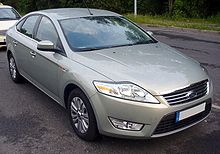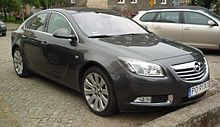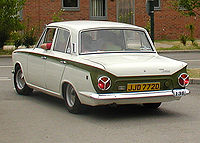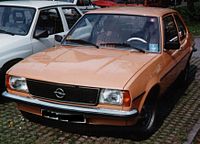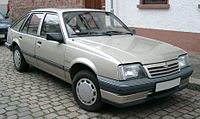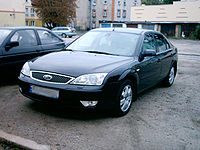- Large family car
-
A large family car, also known as a D-segment car, is a European automobile classification which is larger than a small family car and smaller than an executive car. Multi-purpose vehicles based on a large family car design are often called large MPVs, while similarly-priced models from luxury car manufacturers in the D-segment are called compact executive cars. Large family cars are generally equivalent to a non-luxury mid-size car in North America and Australia, though mid-size cars are often the same size or larger than executive cars (i.e. mid-luxury cars).
In the United Kingdom for example, typical large family cars include:
- Alfa Romeo 159
- Chevrolet Malibu
- Citroën C5
- Ford Mondeo
- Honda Accord
- Hyundai Sonata
- Kia Optima
- Mazda6
- Vauxhall/Opel Insignia
- Peugeot 508
- Renault Laguna
- Renault Latitude
- SEAT Exeo
- Toyota Avensis
- Volkswagen Passat
Although classified as large in Europe, many of them would be classed as a mid-size in the USA.
Large family cars in the UK since 1970
1960s
Since the launch of the original model in 1962, the Ford Cortina had been firmly established as the most popular large family car in Britain. The 1966 MK2 model picked up where its successor left off, but the MK3 model - launched in October 1970 - just took the Cortina from strength to strength. Its was Britain's best selling car by 1972, and was still in pole position upon the launch of its successor in 1976. The MK4 was mildly updated in late 1979 to become the Cortina 80, and that year the Cortina completed eight successive years as Britain's most popular car.
1970s
British Leyland were the only carmaker to come anywhere near the Cortina's success in the UK. Its 1971 Marina was regularly Britain's third or fourth most popular new car throughout the decade in spite of critics who slated the car for its suspect quality, relatively old-fashioned design and lack of technical flair - its suspension dated back to the 1948 Morris Minor! BL's Austin Maxi received a more favourable public image - boosted by its spacious interior and practical hatchback bodystyle - but was always quite some way behind the Cortina in the sales charts. The similarly-sized Triumph Dolomite was a sporty and stylish alternative to these more mundane offerings, but was produced in relatively limited numbers and never aimed at taking too many sales off potential Cortina buyers.
The Rootes Group became Chrysler UK in 1970 to reflect its takeover by the American carmaker several years earlier, but the ultra-conventional Hunter remained on sale throughout the decade - surviving the Chrysler rebranding of the range and the launch of the far more modern Chrysler Alpine in 1975. It lingered until 1979, the year that financially-troubled Chrysler sold its European operations to Peugeot of France and rebadged the entire Chrysler/Simca range as Talbots. The front-wheel drive Alpine hatchback was arguably the most modern looking large family car on sale at the time of its launch and for some years afterwards, but it never quite managed to achieve the sales success that its makers had hoped for.
Vauxhall's Victor range was fading fast come 1974 in the face of soaring Cortina sales. The solution to this problem came in October 1975 when its Cavalier - a restyled and rebadged version of the German Opel Ascona - went on sale and proved to be an instant success with the fleet market in particular.
By the end of the decade, foreign cars in this sector were still a comparative rarity, though a few overseas models were starting to gain popularity. These included the Volkswagen Passat, Peugeot 505 and Datsun Bluebird.
In 1979, the large family car sector was still the most popular in the UK, with the Cortina, Cavalier, Maxi, Marina and Alpine all selling in high quantities.
1980s
1982 saw the Ford Cortina finish production after 20 years and five incarnations. The final two incarnations had recorded an amazing 1,000,000+ sales in the space of six years in the UK alone. But its conventional three-box saloon bodystyle was starting to look a little dated in the face of one or two newer rivals, and Ford took a radical approach with its successor - the Sierra, which maintained the Cortina's rear-drive layout but used a hatchback body rather than a saloon one, and had aerodynamic styling which was a world away from the Cortina's boxy looks. Initial sales were mixed, but popularity soon soared and the Sierra was one of the most popular cars in Britain during the 1980s, with mild makeovers in 1987 and 1989 making it more appealing.
Back in 1977, General Motors had set about designing a class-leading and innovative new car for European buyers to take on the might of the Ford Cortina and other similar products. The original Cavalier had been a huge success in the UK, but its successor - launched in 1981 - was even more successful. It featured front-wheel drive as well as the option of a hatchback bodystyle, as well as class-leading levels of fuel economy and performance. Prices were also competitive, and for much of its production life it was the most popular large family car in the UK. By the time its successor was launched in 1988, the MK2 Cavalier had sold more than 800,000 examples in the space of seven years! The MK3 Cavalier was also an instant hit with buyers thanks to its sleek styling, good handling, refined engines and generous equipment levels.
With the Morris Marina looking more and more dated, British Leyland employed Giugiaro's ItalDesign studio to update it. The result - completed over the summer of 1980 - was the Morris Ital. It looked quite different to the Marina, but was still dated in comparison to many other similarly-sized cars at the time and there were no initial modifications to its ageing mechanical layout. Improvements in 1982 saw the introduction of an impressive new 2.0 engine from the Rover SD1, but the Ital was looking way behind the best of its competitors when it was replaced by the Austin Montego in 1984. The front-drive Montego was a considerably better car than the Marina and Ital, but it was never able to match the huge success of the Ford Sierra and Vauxhall Cavalier. The Rover 400 was shown in 1989 and scheduled to start production at the beginning of 1990, marking the beginning of the end of Montego production.
The Talbot Alpine was still a fairly popular car in 1980, when the range expanded to include the Solara saloon. But sales began to fall over the next couple of years with the advent of the Ford Sierra and Vauxhall Cavalier, and it couldn't even hope to compete with the Morris Ital in terms of sales success. So production was pruned back after 1984 when the range was re-badged as the Minx and Rapier - with these Rootes era names being assigned to the models in accordance with trim level rather than bodystyle. Production ceased in 1986 when Peugeot decided to shelve the Talbot marque on passenger cars (reserving it for commercial vehicles) and use the Ryton plant for its own models. The first large Peugeot to roll off the Ryton production line was the Peugeot 405, which was launched at the end of 1987 and wowed the press and motoring public alike with its splendid Pininfarina-penned body and ultra-stiff chassis which gave class-leading ride and handling. It attracted high sales almost from the very first day and gave the chart-topping Sierra and Cavalier its first serious French competitor on the UK market. Another key factor in the 405's success was its impressive specification, which included the availability of four-wheel drive, fuel injection and 16-valve engines on more expensive variants. The diesel units were also impressive in terms of sturdiness and refinement.
Japanese carmaker Nissan built a factory at Sunderland in 1986 and it initially produced only one type of car - the Bluebird, a solid and reliable alternative to the Sierra and Cavalier. The Bluebird's sales were strong, and by the end of the decade it had been confirmed that the Bluebird's successor would also be rolling off the line at Sunderland, with more of the marque's products to join it at a later date.
By the end of the 1980s, Ford, Vauxhall, Rover and Peugeot were the established and most favoured brands in the large family car sector, but this didn't stop many other carmakers from giving them a run for their money with overseas imports. These included the Renault 21, Citroën BX, Volvo 440/460, Toyota Carina, Honda Accord and Volkswagen Passat.
The 1980s also saw the large family car sector endure a slight decline in popularity among British buyers, as more and more of them were aspiring towards better-equipped small family cars including the Ford Escort, Vauxhall Astra, Volkswagen Golf and Rover 200.
1990s
1990 was a successful year for Vauxhall. Its Cavalier sold 138,000 units in the UK and outsold the Ford Sierra. In fact, only one other car - the Ford Escort - managed to outsell the Cavalier at all that year. Its success continued and it remained top of the large family car sales charts for four years. In its final year, 1995, the Cavalier was still Britain's fifth most popular car. The Vectra that replaced it managed to enjoy a similar level of success in spite of some heavy criticism over reliability issues and the lack of driving and design flair, which were remedied with a mild facelift in early 1999 with oversaw a famously advertised 2,500 improvements.
Ford's Sierra moved into the 1990s still looking fairly modern even though its tenth anniversary was approaching, thanks largely to a series of mild updates which smartened up its appearance and bolstered specification levels. Its successor finally came in February 1993 when the all-new Mondeo went on sale and carried on where its predecessor left off, establishing itself as Britain's best selling large family car for most of the rest of the 1990s.
Rover's new 400 Series, launched at the beginning of 1990, gave buyers a classy and smooth-riding alternative to the ageing Montego, which lingered on in limited figures until the end of 1994. The 400 failed to sell as well as the Montego, but this was partly explained by the fact that it was marketed as a saloon version of the slightly smaller 200 Series - even though it was nearer in size to cars in the upper sector. Rover simplified its range in 1995 when the new 400 Series was launched in a format entirely different to that of the new 200 Series, although its relatively compact dimensions and high equipment levels meant that it was competing a size above its weight. This confusion was simplified in 1999 when the 400 Series was facelifted to become the Rover 45.
The Peugeot 405 continued to sell in huge numbers and was one of Britain's most popular large family cars right up to the launch of its successor - the 406 - in late 1995. The 406 didn't sell in volumes quite as high as the 405, but it was still one of the most popular choices in its sector thanks to sleek looks, a comfortable interior and outstanding ride and handling.
By the end of the 1990s, the large family car sector's share of the large family car sector had dipped slightly, even though Ford and Vauxhall offerings were still featuring near the top of the sales charts. The creation and success of the Compact MPV sector - spearheaded by the 1996 Renault Scenic - was partly to blame for this.
2000s
The third generation Ford Mondeo was launched in late 2000 and was Britain's most popular choice in this sector right up to its replacement by the third generation Mondeo in the spring of 2007. The MK3 Mondeo was streets ahead of its predecessor in terms of visual appeal, refinement, build quality, value for money and equipment, but its market share declined throughout its production life. In 2001 it was the sixth most popular car in the UK, but had slumped to tenth place in 2003 and over the next three years came ninth.
Vauxhall's Vectra entered its second incarnation in April 2002 and was an improvement over its predecessor in terms of quality, refinement, equipment and comfort, but wasn't as good to drive as some people might have expected. However in 2007 it outsold the Ford Mondeo.
Other popular choices in the large family car sector this decade include the Volkswagen Passat, Toyota Avensis, Peugeot 407 and Mazda 6. The sector has taken another slight decline over the last few years, with more buyers opting for upmarket small family cars, Crossover SUV's and Compact MPV's. The launch of Ford's new Mondeo in 2007 is seen by many as the car to revive the declining fortunes of this sector in the UK, as does the recently-released Vauxhall Insignia which was voted 2009 European Car of the Year
Sales of the Nissan Primera (launched at the end of 2001) had slumped so badly by November 2006 that Nissan's British operations withdrew it from the British market, though production for export markets ended in 2008. Nissan bosses confirmed that a successor will be launched in due course, but have yet to confirm whether it will be sold in Britain.
See also
Categories:- Car classifications
Wikimedia Foundation. 2010.

